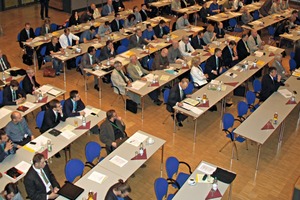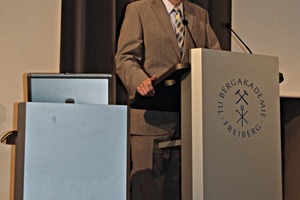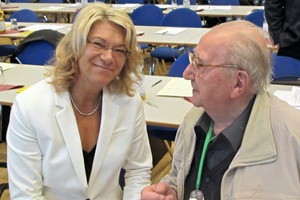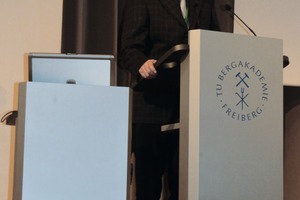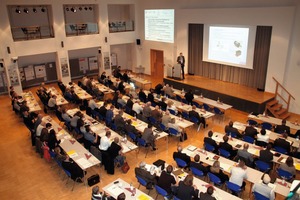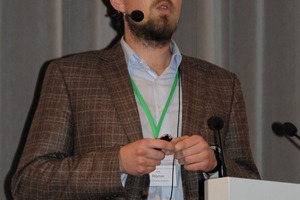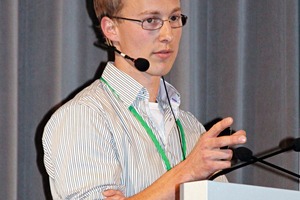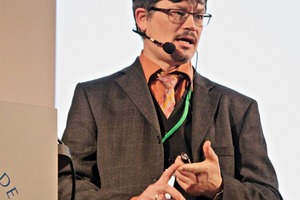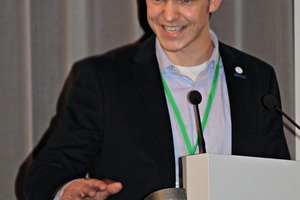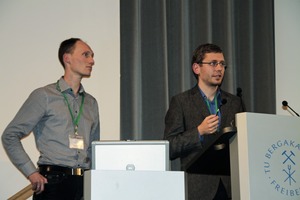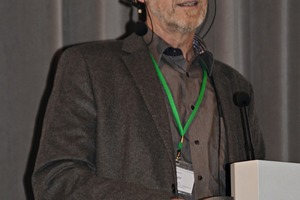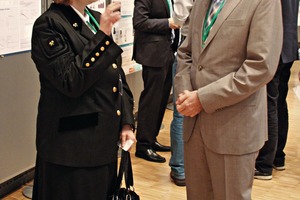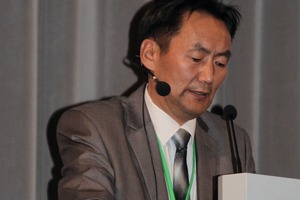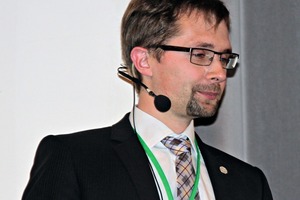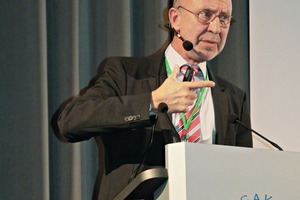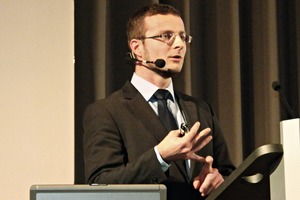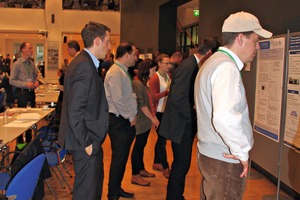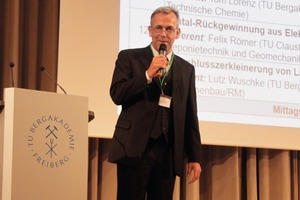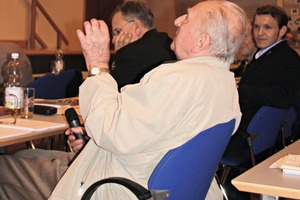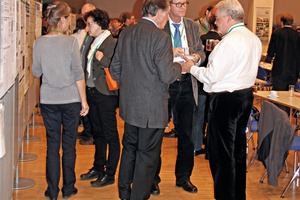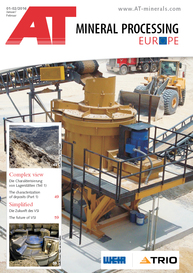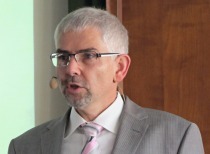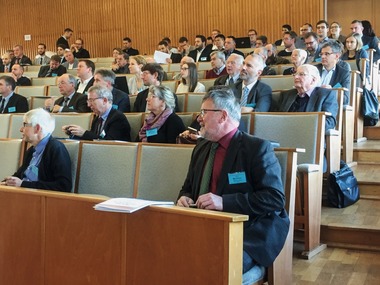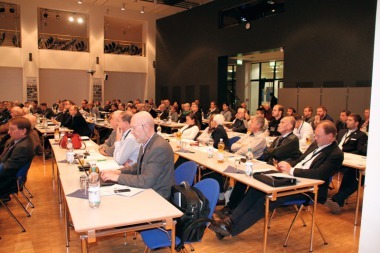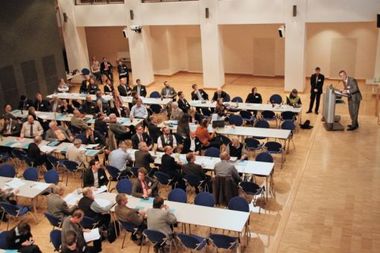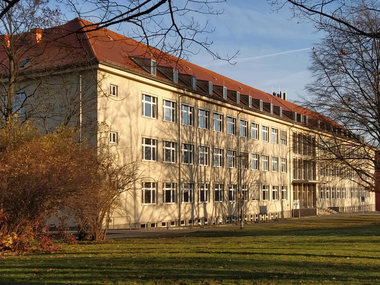Annual conference “Processing and Recycling 2015” in Freiberg
The annual conference “Processing and Recycling” on 11 and 12 November 2015 was one of the events organized on the occasion of the 250th anniversary of the founding of Freiberg University of Mining and Technology. This conference has been organized regularly since 1998. With 130 experts from home and abroad, the conference again met with a very good response (Fig. 1). With 25 lectures, 22 posters and five company presentations in the “Old Refectory” function room of Freiberg University of Mining and Technology, the historical importance of the University in the field of processing was outlined and the latest research findings on the use of primary and secondary raw materials presented.
1 Teaching and research on processing at the University
Dr H. Morgenroth, Managing Director at UVR-FIA GmbH, welcomed the attendees to the conference (Fig. 2) and, together with the co-author Dr T. Mütze, acknowledged in their lecture “250 years of the Freiberg University of Mining and Technology – development of teaching and research in the field of processing” the importance of the oldest mining college in the world in this field of science. It was mentioned that Prof. Gätzschmann published a textbook on mineral processing already 150 years ago. In 1950 Prof. Kirchberg established mineral processing as separate field of study and in 1954 the Freiberg Research Institute of Mineral Processing was founded outside the university. Furthermore, they reported on the excellent education at the University and the outstanding research findings obtained. In particular, they underlined the personality of the doyen Prof. Heinrich Schubert who worked there for decades from 1960 (Fig. 3).
Dr W. Schubert (Titania AS Norway) is a graduate of the University and described the good cooperation between the university and partners from industry in his talk on “The use of process models developed in Freiberg in practice” (Fig. 4). In his lecture he explained the use of some process models developed to design hydrocyclones, hydraulic classifiers and flotation equipment, the carefully controlled adjustment of reagent regimes using steric properties of various non-polar promoter groups during flotation as well as the design of vibrating silo outlets and the prediction of the filter cake purity after washing.
Prof. S. Schade-Dannewitz (Nordhausen University of Applied Sciences) (Fig. 3) showed in her lecture “Waste as raw material resource – studies and research in the course ‘Environmental and Recycling Technology’ at Nordhausen University of Applied Sciences” that the elementary fundamentals of processing are relevant both for waste and recycling management as well as for recycling technology. With her studies and doctorate in Freiberg with Prof. Schubert, she obtained an excellent basis for her further professional career. Nordhausen University of Applied Sciences attaches great importance to application-oriented, interdisciplinary and networked research as well as technology transfer. The course of studies has so far raised € 3.65 mill. in project funding and for R&D orders. It organizes the Nordhausen Secondary Raw Material Workshops, the 8th edition of which met with great response in 2015.
2 Trends in recycling
The focus of research activities of recycling is on the recovery of valuable metals. For example, an indispensable prerequisite for economic recovery of rare earth metals from FeNd magnets by means of pyrometallurgical and hydrometallurgical processes is the existence of highly enriched magnetic scrap concentrates. The “Investigations to cover the FeNd magnetic materials from ELV, mixed and collected scrap” by Dr H.-G. Jäckel (Fig. 5) and M. Starzinsky (Freiberg University of Mining and Technology – IMB/RM) regarding contactless detection of the magnetic materials in recoverable material mixes, particularly scrap, both in laboratory- and industrial-scale scrap processing resulted in essential fundamentals to detect and separate these high-performance magnetic materials. Thus, it was possible to conduct a volume analysis regarding the material composition (magnetic materials with/without Nd) and the amount yielded (in kg/year).
With the concept of solid chlorination by means of carefully controlled coupling with a downstream leaching step presented by T. Lorenz, Dr P. Fröhlich and Prof. M. Bertau (Freiberg University of Mining and Technology – Institute of Technical Chemistry) in their lecture “Recycling of rare earths from permanent FeNdB magnets”, a new process management and, consequently, an effective, less chemical-intensive alternative was developed compared to the classical wet-chemical process.
F. Römer1 (Fig. 6), M. Bergamos2 and Prof. D. Goldmann1 (1Institute of Processing, Landfill Technology and Geomechanics, Clausthal University of Technology, 2ELPRO Elektronik-Produkt Recycling GmbH, Brunswick) reported on “Tantalum recovery from electronic scrap”. With comminution and sorting studies based on electronic scrap components rich in Ta from vehicles and circuit boards, a processing method could be developed, enabling non-destructive and particle-size-selective concentration of the tantalum capacitors achieving tantalum concentrates of more than 25 %.
A successful “Liberation comminution of traction batteries with Li ions” is the basis for separation of the valuable materials contained. It was presented in the lecture given by L. Wuschke1, Dr H.-G. Jäckel1, M. Gellner2 and Prof. U.A. Peuker2 (Freiberg University of Mining and Technology, 1Chair of Recycling Equipment, 2Institute of Mechanical Process Engineering and Mineral Processing). Two students (Mr Borsdorf and Mr Werner) reported on the results because the first author was ill. The specific mechanical energy consumption, the mass recovery and the degree of liberation for the comminution units, i.e. rotor shredder, rotor shears, cutting mill and hammer mill, were investigated to obtain a feed material, which can be sorted efficiently, for the subsequent process steps (classifying and airflow sorting).
Germanium is an indispensable element for the production of optical waveguides and was classified as critical raw material by the European Commission in 2010 owing to the great risks of supply and the high raw material price. V. Recksiek (Fig. 7) and Prof. Ch. Scharf (Freiberg Helmholtz Institute of Resource Technology) informed attendees about the research work dealing with the “Recovery of germanium from glass fibre scrap” yielded during the production process. While preliminary forms of pure glass not coated with plastics can be crushed in ball mills to the desired particle size, scrap coated with plastics has to be processed by means of combined cutting and shear mills. Glass and plastic fractions can be separated as far as possible by means of screening and separation after grinding. The oxides can be converted to germanium tetrachloride and silicon tetrachloride as well as separated by means of distillation in a planned downstream metallurgical process.
Large amounts of fine-grained residual products are inevitably yielded during many metallurgical processes that are mainly distinguished by high contents of valuable materials and significant harmful substances. The lecture given by Dr W. Öfner (Leoben Mining University/Austria) with the title “Description of fine-grained residual products from metallurgy and their preliminary processing for better reuse” showed the complexity of the task and possible ways of solution based on the example of eight different dusts differing in their chemical composition, fineness, solubility, tendency to agglomerate, degree of intergrowth, etc. A mechanical-physical separation process is preferred (Fig. 8).
In their lecture “Gypsum in demolition waste – problems and approaches of solution” Dr K. Weimann and Dr B. Adamczyk (Federal Institute of Material Research and Testing, Berlin) reported on the amounts yielded and the possibilities to remove the disturbing gypsum portion from mineral secondary building materials. The separation of gypsum-containing materials is more favourable during demolition than sorting during the processing of demolition waste.
Ch. Straub, Dr M.V.A. (Miruna) Florea and Prof. H.J.H. (Jos) Brouwers (Eindhoven University of Technology) informed about the “Utilization of by-products from glass recycling in autoclave foamed concrete”. The fine-grained portions yielded during processing of recycling glass cannot be used again for the glass production owing to the high content of impurities. The direct use in cement or lime building materials is not possible either owing to the risk of the so-called alkali expansion. The alkalis are bonded in the crystal lattice of the tobermorite formed in building material hardened in the autoclave. Even higher strengths are achieved owing to the higher reactivity of the silicic acid as opposed to quartz so that up to 40 % of quartz can be replaced. A higher substitution rate, however, leads to a negative influence on the pore structure of the building material.
3 Sorting process in ore dressing
In his lecture “To understand the floatability – investigations regarding specific surface energy distributions and hydrophobic interactions”, Dr M. Rudolph (Freiberg Helmholtz Institute of Resource Technology) informed attendees about basic investigations concerning total atomic interactions between differently wetted surfaces (e.g. minerals) and hydrophobic model particles in solution by means of the particle probe atomic force microscopy (Fig. 9). Furthermore, the method of the inverse gas chromatography was applied with which the change of the specific surface energy distribution as fundamental wetting parameter can be investigated and be connected to the flotation in the microflotation.
After centuries of mining in the Erzgebirge region there are many mine dumps that represent potential resources in current terms of raw material policy. In their tandem lecture “Processing of reclamation sand from Ehrenfriedersdorf – investigations into the density separation and flotation methods to extract fine and very fine cassiterite” Th. Leissner1 reported on density separation and T. Leistner2 reported on flotation (Fig. 10) together with their co-authors M. Embrechts2, B. Michaux2, I. Osbahr2, R. Möckel2, Dr M. Rudolph2, Prof. J. Gutzmer2 and Prof. U.A. Peuker1 (1Institute of Mechanical Process Engineering and Processing at Freiberg University of Mining and Technology, 2Freiberg Helmholtz Institute of Resource Technology). Based on the results of the Mineral Liberation Analyzer (MLA), various cuts were determined and sample material of defined orders of magnitude was produced by means of cross-flow classification. The experimental investigations were carried out on the classified material. Statements regarding the output and the enrichment of the cassiterite in the individual process steps were obtained by means of the content determination of the process products using the X-ray fluorescence analysis.
I. Bremerstein and A. Kruckow (UVR-FIA GmbH Freiberg) reported on “First experience gained with the use of sorting centrifuges”. Sorting centrifuges are equipped with vertically rotating, conical cylinders operating with many times the gravitational acceleration and used for the density separation of ores. The advantage as opposed to other processing methods is the clearly higher throughput and the smaller space required. The potential of the laboratory centrifuge as regards the attainable purity and output was systematically investigated using reference material. It was used for sorting, e.g. of dump material for the extraction of tin and of industrial waste for rare earth minerals.
The lecture “The use of the Mineral Liberation Analyses (MLA) for the processing of Y-containing rare earth ores” given by R.G. Merker (MMP Elpenrod), Prof. Dr B. Schulz (TUBAF Freiberg), Dr H. Morgenroth (UVR-FIA Freiberg) and T. Leissner (TUBAF Freiberg) contained interesting information (Fig. 11). The results of the investigations with the MLA were compared using virtual fractions and real grain fractions obtained by screening. Only virtual results for grain fractions < 25 µm deliver relatively safe values. In case of coarser fractions, the number of the particles evaluated with the MLA is too small and, therefore, better results are obtained with real grain fractions.
In her lecture “Trends of developments in the mining industry”, Dr L. Grossmann (Siemens AG Erlangen) presented her knowledge derived from international development (Fig. 12). After the excessive capital spending between 2004 and 2012 to create new capacities, for the time being a clear decline can be seen. An analysis of the current factors of influence makes it possible to evaluate the future trends with information technology having a key position.
4 Comminution and classifying
The investigations into “The comminution behaviour of dolomite” conducted by T. Fraszczak1, Dr T. Mütze1, Dr habil. B. Lychatz2 and O. Ortlepp3 (1,2Freiberg University of Mining and Technology, 1Institute of Mechanical Process Engineering and Processing, 2Institute of Iron and Steel Technology, 3Wünschendorfer Dolomitwerk GmbH) were necessary because the Wünschendorfer Dolomitwerk GmbH is gradually switching over from surface mining to underground extraction for the production of calcined dolomite. In doing so, they expect a changed rock morphology. Tests concerning the pressure and impact loading showed that during pressure loading in jaw crushers and multiple stresses in the case of medium comminution conditions it is possible to reduce the portion of fines in the comminution product and to achieve considerably higher outputs of > 10 % of the fraction of 25 –63 mm.
D. Enkhbat (Fig. 13), graduate of Freiberg University of Mining and Technology, together with the co-authors Ch. Erdenenyam and Yo. Majigsuren (Faculty of Geology and Mining of the Mongolian University of Science and Technology) reported on “Investigations into the processability of iron ore samples from the iron ore deposit of Tamiriin Gol in Mongolia”. Based on the locally investigated mineral composition and the magnetic properties, four different types of iron ore (ore zones rich in magnetite, rich in haematite, magnetite-haematite mixed and oxidized ore zones) were determined, and samples were taken for the processability tests with wet magnetic separation.
G. Kretschmar1, T. Fraszczak2, Dr T. Mütze2 (Fig. 14) and F. van der Meer3 (1Knauf Gips AG, 2Freiberg University of Mining and Technology, Institute of Mechanical Process Engineering and Processing, 3WEIR Minerals) informed attendees about “The influence of material humidity on the classifying performance of air separators”. In addition to the factors depending on the design and the mode of operation, the condition of dispersity of the bulk solids determines the results of separation. The investigations were performed with four laboratory separators, i.e. a gravity counter-current separator (type Petkus), a multistage gravity cross-flow separator (zigzag separator from the company Alpine) and two laboratory repellent wheel separators (100 MZR and TC-15 M from the company Alpine), with mineralogically and granulometrically characterized iron ore samples wetted with a water content of up to 10 %. The result showed that there is a good dispersion in centrifugal separators with water content up to 3 %. However, an intensive predispersion will be required for a water content of 3 to 6 %. Up to 3 % there is a good separation in case of gravity separators with the zigzag separator, while the single-stage Petkus separator is not suitable above 2 %. An essential factor during the separation processes may be the initial moisture of the separating air and the contact time of the material with dry fresh air.
In their lecture “Reducing comminution barriers – new dimensions of particle size comminution and liberation by means of the VeRo Liberator®”, Prof. G. Borg1,2 (Fig. 15), F. Scharfe1, Prof. Ch. Lempp3 and A. Kamradt2 (1PMS, Hamburg, 2Field of Petrology and Deposit Research, Martin Luther University, Halle-Wittenberg, 3Field of Engineering Geology, Martin Luther University, Halle-Wittenberg) reported on a crushing machine enabling very large comminution factors with a throughput of 100 t/h and a very low energy consumption of < 2.3 kWh/t. The basis of the principle is that impact tools rotate in opposite sense around vertical axles with a very high velocity on three levels. The new comminution principle was tested with different ores, slags and other heterogeneous solids. For example, a massive sulphide ore from the deposit Rio Tinto in Spain with an initial particle size of 120 mm could be comminuted at a size reduction ratio of 480 to < 250 µm with a yield of 94 %.
After explaining the principle of the electrohydraulic comminution technology, T. Müller and S. Eisert (ImpulsTec GmbH Dresden) presented the “Application potential of the shock wave process for the recycling of complex industrial materials”. The process makes it possible to separate solid materials at weak points in the structure. Thus, components of solar modules, of lithium ion battery cells, of circuit boards, of electrical components, of coated materials, but also of ores can be isolated so that a subsequent separation can be carried out. Plants with throughputs of up to 200 kg/h are available.
Based on the presentation and discussion of various circuit alternatives of mill and separator, P. Büttner1 (Fig. 16), Dr H. Günter2 and Prof. H. Lieberwirth1 (1Freiberg University of Mining and Technology, Institute of Mineral Processing Machinery, 2Köppern Aufbereitungstechnik GmbH & Co. KG) presented a “New separator concept to increase throughput during cement grinding”. On the one hand, the new alternative consists of a static cascade separator and, on the other hand, of a dynamic air-swept lamella type classifier. Both separators are operated with the same air volume flow. Both flakes from high-pressure grinding rolls and discharged materials from ball mills are fed to the separator. The throughput is increased from 18 to 24 % with completely comparable cement properties as opposed to pure ball mill cement.
5 Processing by means
of bio- and hydro-metallurgy
The term ‘technology metals’ has been used in the last decade only meaning rare metals (Co, U, La, Nd, Cd, Li, Y, Bi, Dy, Se, Sm, Zr, Ga, In, Tb, Eu, Pd, Pt, Ge, Ga, Re, Rh, Hf, Ta, Sc, Te, Th) needed for the production of high-tech equipment and technical systems. The lecture “Leaching kinetics of technology metals” given by Dr H. Kalka1, J. Krause1, Dr H. Märten1,2, Dr J. Nicolai1 and M. Zauner1 (1Umwelt- und Ingenieurtechnik GmbH Dresden, 2Heathgate Resources Pty. Ltd., Adelaide/Australia) summarized the latest findings in this field. As regards the presented types, the reactive transport in permeable deposits under saturation conditions, heap leaching as well as tank and autoclave leaching were described including the ore mineralogy, the leaching chemistry and the physical parameters in all cases. The types also permit the up-scale of laboratory conditions to industrial-scale dimensions.
“The recovery of indium from highly diluted bio-leaching solutions by means of liquid-liquid extraction” was the focus of the lecture given by R. Vostal, Dr P. Fröhlich, and Prof. M. Bertau (Freiberg University of Mining and Technology, Institute of Technical Chemistry). A polymetallic solution can be produced from native sphalerite ore by means of microorganisms. This solution contains Zn and Fe as main components, but also small amounts of indium. To be able to recover the indium, it must be concentrated up to 10 000 times and separated from the other metals. During model experiments with Di-(2-ethylhexyl) phosphoric acid (DEHPA), an initial concentration of 500 mg/l containing 11 mg/l of indium was created. The companion elements zinc and iron were also extracted in limited amounts only. In a further step using Cyanex 923, a mix of organic phosphine oxides, it was possible to remove indium completely from the re-extraction solution, extracting only 10 % of the iron.
M. Martin, Dr E. Janneck, R. Kermer, A. Patzig and S. Reichel (G.E.O.S. Ingenieurgesellschaft mbH Freiberg) reported on the “Extraction of zinc and indium from zinc blende and dump material by means of bio-leaching and the following recovery from the leaching solutions”. They investigated flotation residues of the dumps “David Schacht” and “Hammerberg” near Freiberg. Owing to the high portion of zinc blende from Freiberg in the material, the zinc concentration amounted to 6-12 g/kg, and indium existed as further valuable element with a concentration of 10-15 mg/kg TS.
Zinc blende is leached by microorganisms via the polysulphide mechanism. First the bonding between the metal and sulphur is split before the oxidation of the sulphide sulphur by means of Fe3+ takes place. The thus created polysulphides can be degraded to become elementary sulphur, which in turn is further oxidized again microbiologically under acid conditions to become sulphuric acid. First the basic process conditions (pH, particle size, solid portion) are determined by means of shaking flask and column tests. Then they are optimized in the batch bioreactor scale. A recovery of 100 % of zinc, of approx. 80 % of indium and of up to 40 % of solids could be achieved. A strategy was developed for the concentration of indium, with which it is possible to separate aluminium, iron as well as Zn, Cd and Cu owing to solution and precipitation reactions by varying the pH value and the redox conditions.
6 Poster show and company presentations
This year the conference attendees judged the poster show, which comprised a total of 22 posters (Fig. 17), and the three best posters were awarded prizes, which will be described briefly hereinafter. The “Investigations of the adsorption of flotation reagents by means of an atomic force microscope and the Raman spectroscopy” by B. Babel, Dr M. Rudolph (Freiberg Helmholtz Institute of Resource Technology) and Prof. U.A. Peuker (Freiberg University of Mining and Technology, Institute of Mechanical Process Engineering and Processing) took first place. “The recovery of lithium carbonate from lithium-containing minerals by means of CO2 treatment” by G. Martin, Dr C. Pätzold and Prof. M. Bertau (Freiberg University of Mining and Technology, Institute of Technical Chemistry) came second. The “Characterization of impregnated amberlite XAD 7 HP for the separation of ions of rare earths by means of a separation column” by A. Grohme and Prof. U.A. Peuker (Freiberg University of Mining and Technology – Institute of Mechanical Process Engineering and Processing) came third.
In addition to those from Freiberg University of Mining and Technology and the Freiberg Helmholtz Institute of Resource Technology, posters were exhibited from the Dresden Leibniz Institute of Polymer Research, from UVR-FIA GmbH Freiberg, from Leipzig University, Miskolc University/Hungary, from the Karlsruhe Fraunhofer Institute ICT, from BAM Berlin, Nordhausen University of Applied Sciences and from Eindhoven University of Technology/NL.
Dr. Jakobs GmbH/AKSA Magnet, the Jena-based industrial representation of the Eirich company, SiC Processing Bautzen, Umwelt- und Ingenieurtechnik GmbH Dresden (UIT) and ZEMDES GmbH Dessau-Rosslau were represented with company presentations.
7 Summary and outlook
Again the conference was excellently prepared and organized by “Gesellschaft für Verfahrenstechnik UVR-FIA e.V. Freiberg” in cooperation with the “Freiberg Helmholtz Institute of Resource Technology” and “Freiberg University of Mining and Technology” as well as the staff members of UVR-FIA GmbH Freiberg. Interesting discussions regarding the lectures were initiated by the moderators Dr Morgenroth (UVR-FIA), Prof. Lieberwirth (IAM), Prof. Peuker (IMV-AT), Dr Rudolph (HIF), Dr Jäckel (IMB), Dr Mütze (IMV-AT) and Dr Kamptner (UVR-FIA) (Fig. 18 and Fig. 19). The poster exhibition and the company presentations, which were organized this year again, met with good response from the conference attendees (Fig. 20).
The next conference “Processing and Recycling” is set to take in Freiberg on 9 and 10 November 2016. The event will be organized again by “Gesellschaft für Verfahrenstechnik UVR-FIA e.V. Freiberg” in cooperation with the “Freiberg Helmholtz Institute of Resource Technology” and “Freiberg University of Mining and Technology”. Abstracts regarding lectures, posters and company presentations should be submitted to the organizing UVR-FIA GmbH at the Internet address www.uvr-fia.de, E-Mail $(LEmailto: till the end of July 2016. Access to the lecture abstracts is also possible at the above Internet address.

